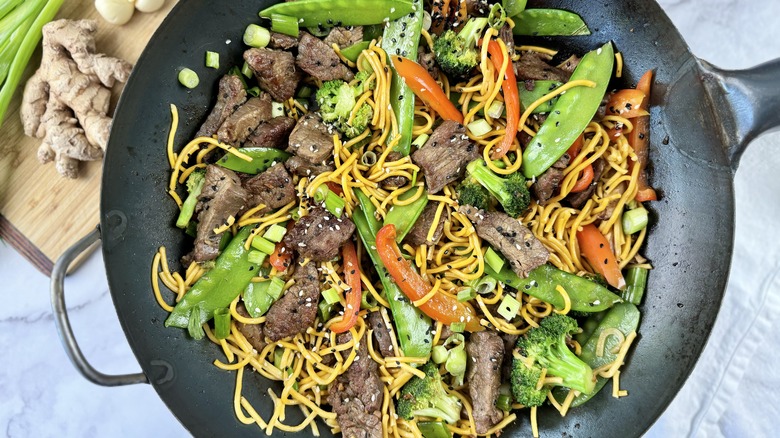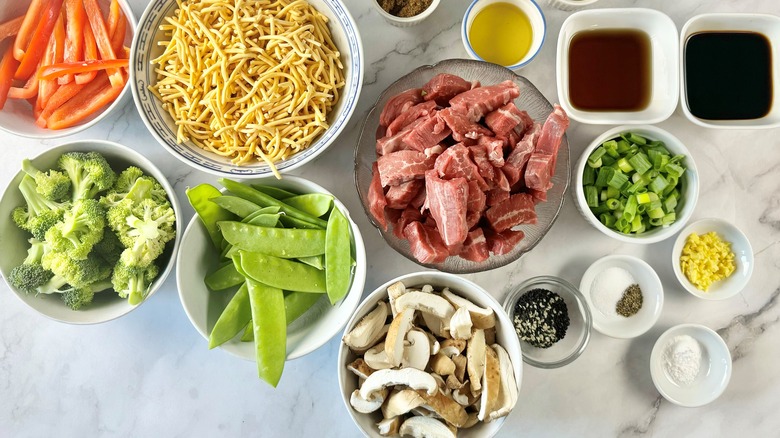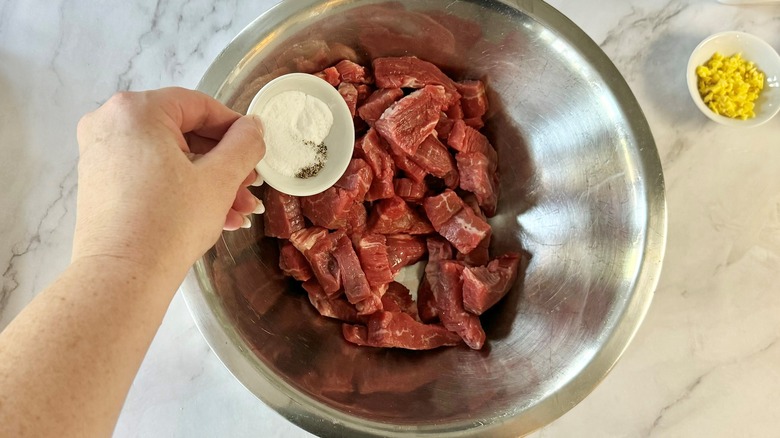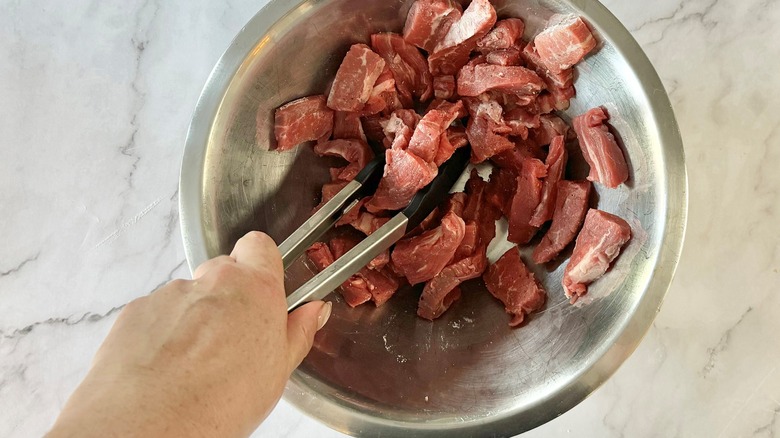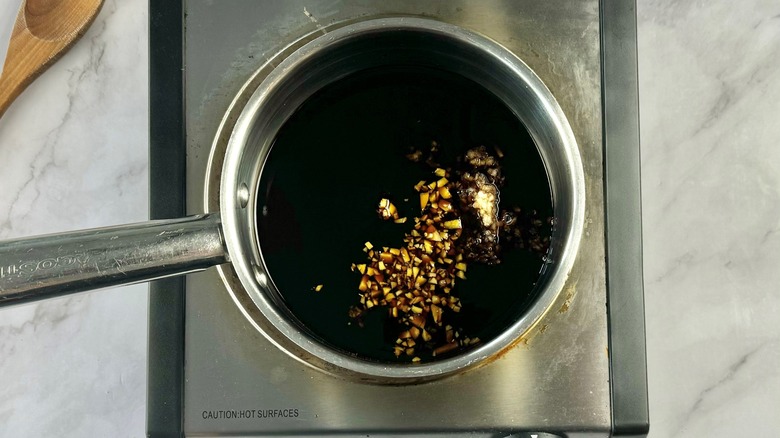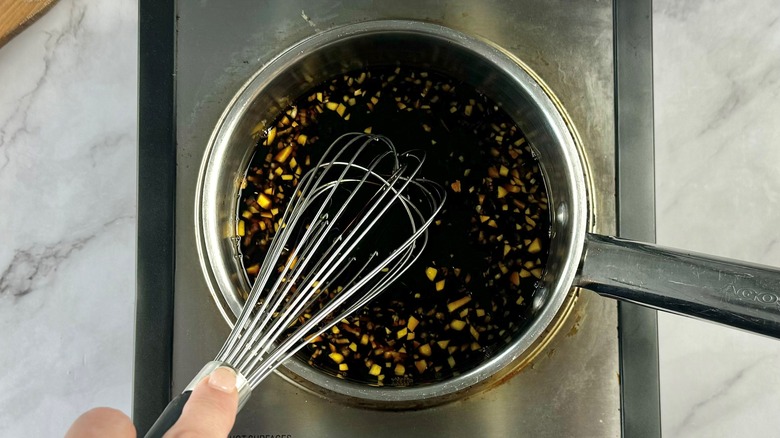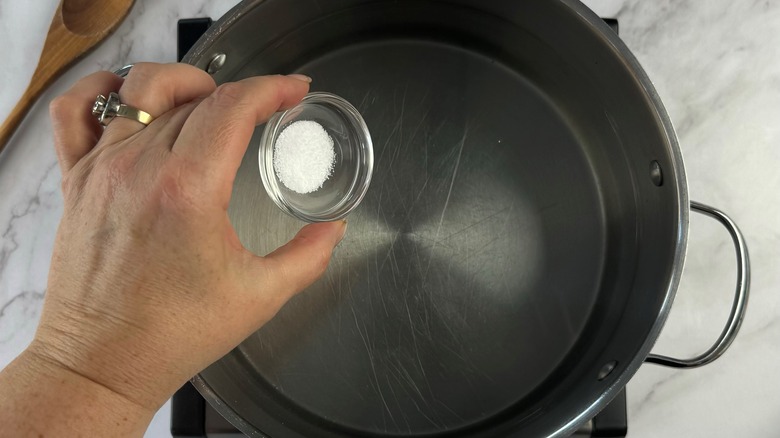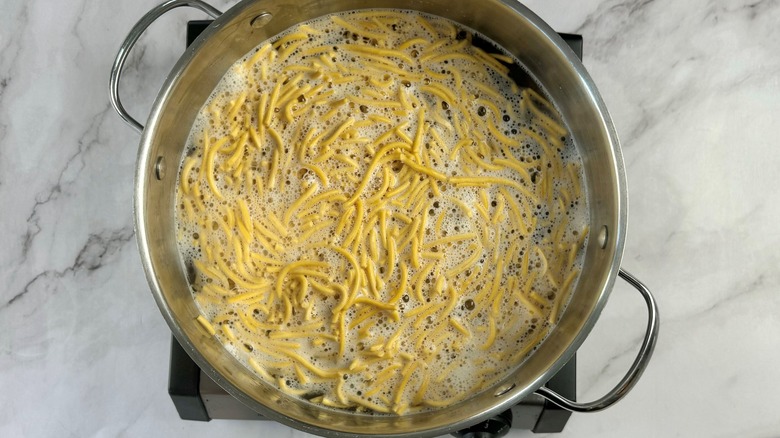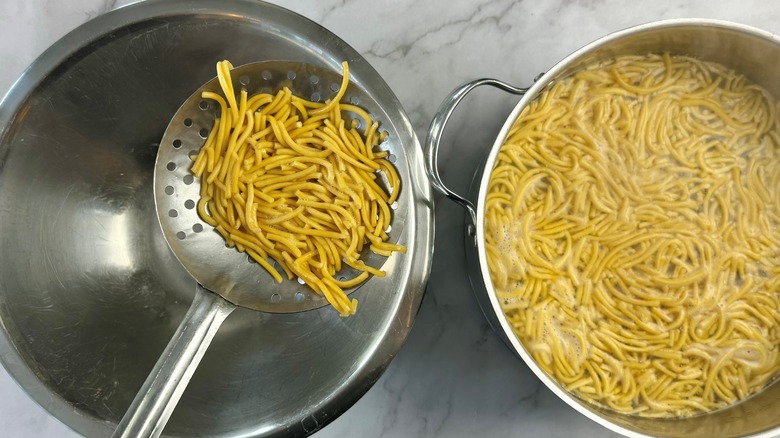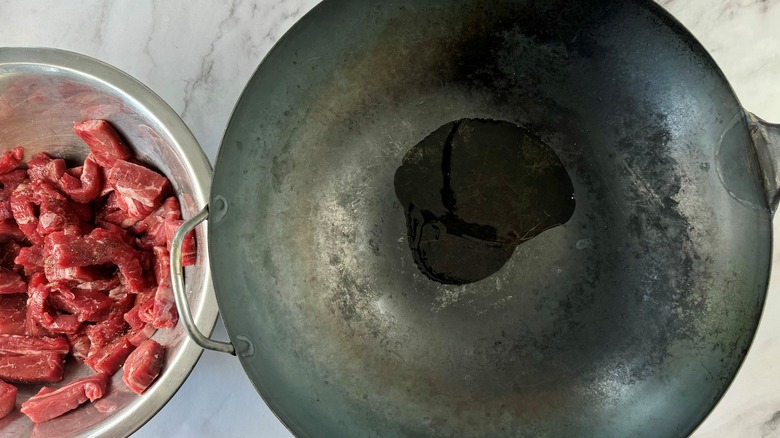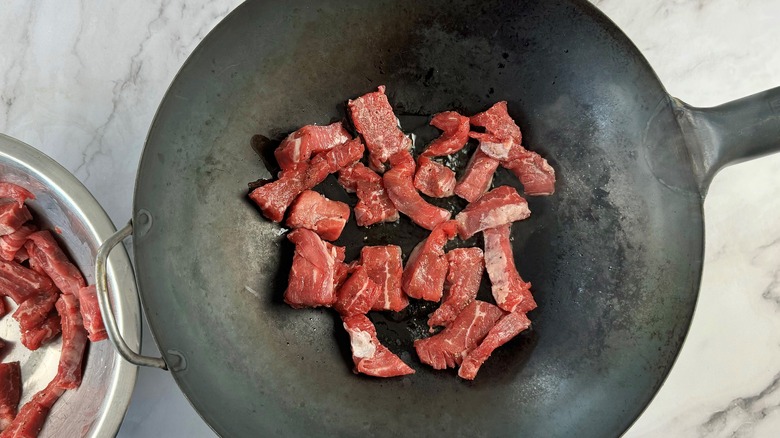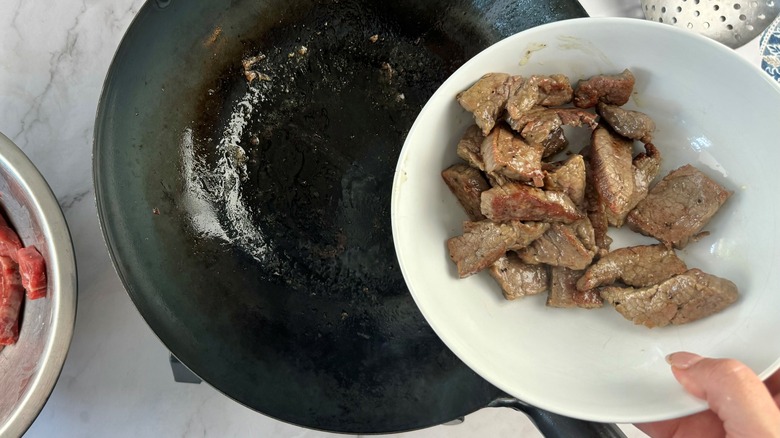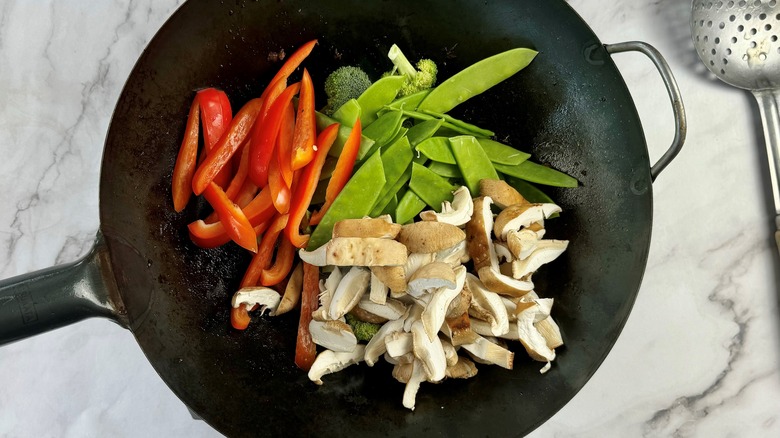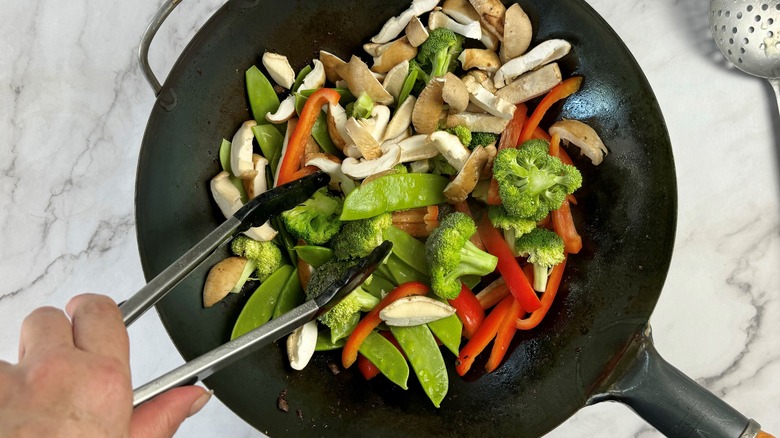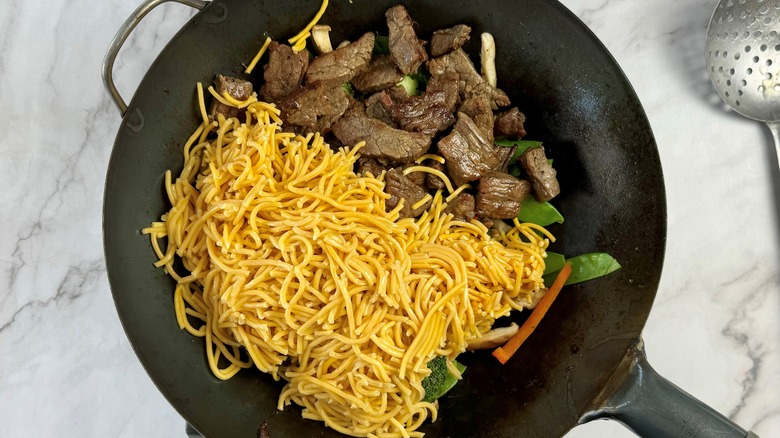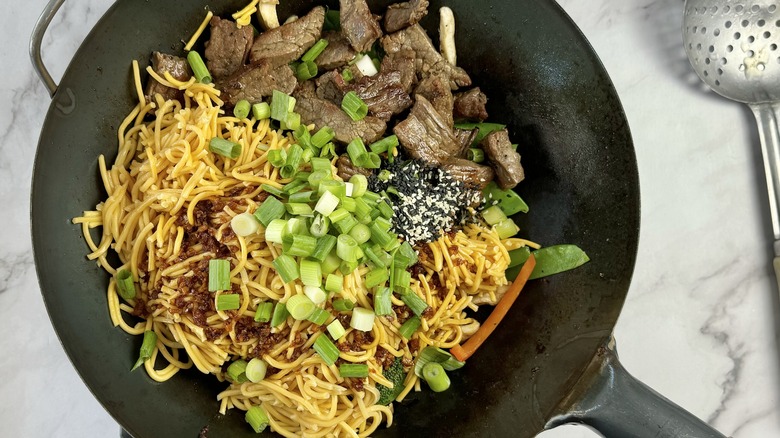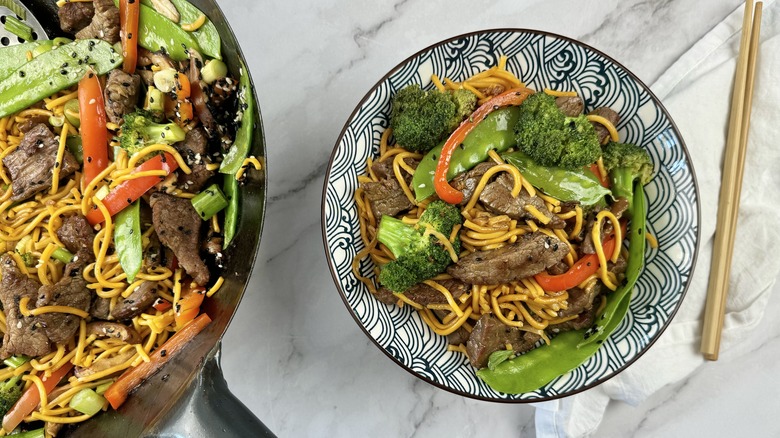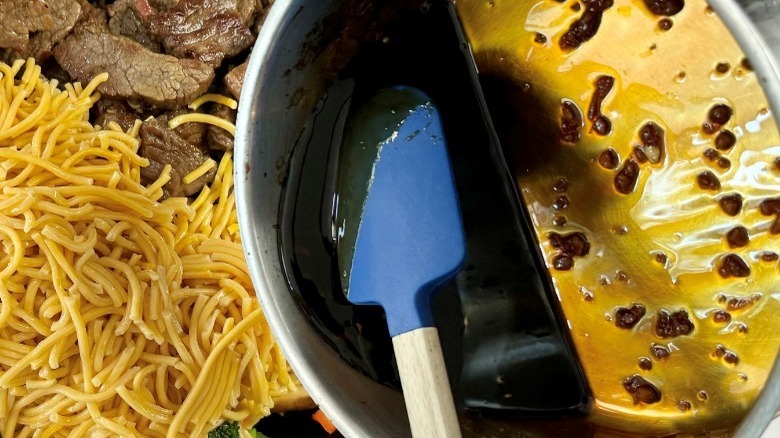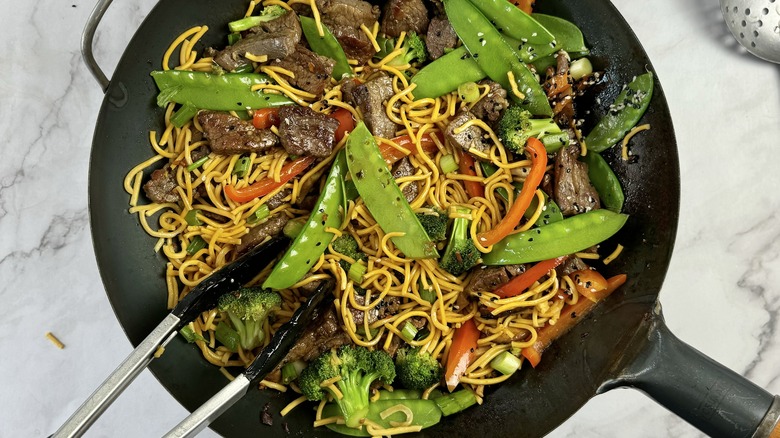Saucy Teriyaki Beef And Vegetable Noodles Recipe
We often associate stir-fries with Chinese food, but this teriyaki beef and noodle dish tastes just like something you'd get in a Japanese restaurant. Developer Julianne De Witt tells us, "I like this recipe because it's hearty and healthy," and it has all of the components that make for a complete dinner: crispy, fresh vegetables, starchy noodles, and succulent strips of beef in a sweet and savory sauce.
If you're surprised to see baking soda used as a dry rub for the steak, the reason for including this secret ingredient is that it's used for velveting, a process many Chinese restaurants use in their stir-fries. When you sprinkle the steak with alkaline baking soda, this raises the pH and breaks down the muscle fibers. Baking soda also seals in moisture, keeping the meat juicy and soft as velvet.
While baking soda may be an unexpected addition to a meat marinade, there's one ingredient that you won't see in this stir-fry sauce. Instead of thickening it with cornstarch, you will simmer it down into a reduction. "The result," De Witt says, "is a concentrated, slightly sweet sauce that works perfectly with the beef and vegetables."
Gather the ingredients for the saucy teriyaki beef and vegetable noodles
This stir-fry starts with steak rubbed with baking soda, salt, and pepper. (De Witt recommends flank steak, but chuck or sirloin will work, as well.) The rest of the dish consists of chow mein noodles, broccoli, snow peas, bell peppers, shiitake mushrooms, and scallions with a sesame seed garnish. You'll also need avocado oil for cooking and soy sauce, mirin, brown sugar, garlic, and ginger to make the teriyaki sauce.
Step 1: Season the steak
Prepare the steak: Add the flank steak to a medium-sized bowl. Top with the baking soda, salt, and pepper.
Step 2: Marinate the steak
Using tongs, massage the ingredients into the meat. Set aside for 30 minutes.
Step 3: Combine the sauce ingredients
Make the teriyaki sauce: Add the soy sauce, mirin, sugar, garlic, and ginger to a small saucepan over medium heat. Whisk the ingredients together.
Step 4: Simmer the sauce
Bring the sauce to a boil, then simmer for 15 minutes, until the sauce has reduced by one third. Set the sauce aside.
Step 5: Boil a pot of water
Start the stir-fry: Fill a large pot with water and add the salt and 1 tablespoon avocado oil. Bring the water to a boil.
Step 6: Cook the noodles
Add the chow mein noodles, then reduce the heat to medium. Cook for 2 minutes.
Step 7: Drain the noodles
Strain the noodles into a bowl and reserve the cooking water.
Step 8: Heat some oil
Add the remaining 2 tablespoons oil to a wok and place over medium-high heat.
Step 9: Brown the beef
Sear the beef in two batches on both sides until browned, approximately 1 ½ minutes per side.
Step 10: Remove the beef from the pan
Set the beef aside.
Step 11: Put the vegetables in the pan
Top with a ladle of the reserved noodle water. Stir and cook for 2 minutes.
Step 12: Cook the vegetables
Reduce the heat to medium. Add the broccoli, snow peas, peppers, and mushrooms to the wok.
Step 13: Stir in the sauce, noodles, and beef
Add the beef, noodles, and teriyaki sauce to the wok and stir.
Step 14: Sprinkle in the scallions and seeds
Add the scallions and sesame seeds. Stir and cook for 2 more minutes, until the vegetables are al dente.
Step 15: Eat the teriyaki beef and noodles
Serve.
Saucy Teriyaki Beef and Vegetable Noodles Recipe
Easy stir-fries are always delicious meals, and this recipe goes the classic route with strips of flank steak, a vegetable medley, and teriyaki sauce.
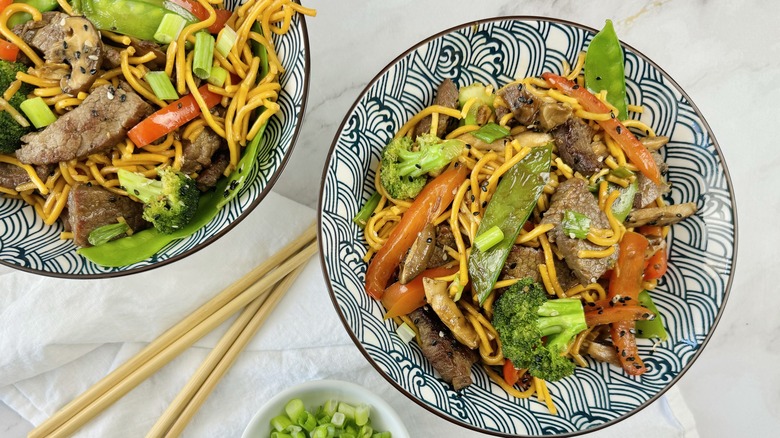
Ingredients
- For the flank steak
- 1 ½ pounds flank steak, cut into 2-inch strips
- ½ teaspoon baking soda
- ½ teaspoon sea salt
- ½ teaspoon freshly ground black pepper
- For the teriyaki sauce
- ½ cup soy sauce
- ½ cup mirin
- 2 tablespoons brown sugar
- 3 cloves garlic, crushed
- 1 tablespoon minced ginger
- For the stir-fry
- 1 teaspoon sea salt
- 3 tablespoons avocado oil, divided
- 10 ounces dried chow mein noodles
- 6 ounces broccoli florets
- 4 ounces snow peas, ends trimmed
- 1 red bell pepper, cut into strips
- 4 ounces shiitake mushrooms, stems removed and tops cut into strips
- ⅓ cup sliced scallions
- 1 tablespoon sesame seeds
Directions
- Prepare the steak: Add the flank steak to a medium-sized bowl. Top with the baking soda, salt, and pepper.
- Using tongs, massage the ingredients into the meat. Set aside for 30 minutes.
- Make the teriyaki sauce: Add the soy sauce, mirin, sugar, garlic, and ginger to a small saucepan over medium heat. Whisk the ingredients together.
- Bring the sauce to a boil, then simmer for 15 minutes, until the sauce has reduced by one third. Set the sauce aside.
- Start the stir-fry: Fill a large pot with water and add the salt and 1 tablespoon avocado oil. Bring the water to a boil.
- Add the chow mein noodles, then reduce the heat to medium. Cook for 2 minutes.
- Strain the noodles into a bowl and reserve the cooking water.
- Add the remaining 2 tablespoons oil to a wok and place over medium-high heat.
- Sear the beef in two batches on both sides until browned, approximately 1 ½ minutes per side.
- Set the beef aside.
- Reduce the heat to medium. Add the broccoli, snow peas, peppers, and mushrooms to the wok.
- Top with a ladle of the reserved noodle water. Stir and cook for 2 minutes.
- Add the beef, noodles, and teriyaki sauce to the wok and stir.
- Add the scallions and sesame seeds. Stir and cook for 2 more minutes, until the vegetables are al dente.
- Serve.
Nutrition
| Calories per Serving | 521 |
| Total Fat | 19.7 g |
| Saturated Fat | 5.4 g |
| Trans Fat | 0.0 g |
| Cholesterol | 116.8 mg |
| Total Carbohydrates | 45.6 g |
| Dietary Fiber | 4.2 g |
| Total Sugars | 6.5 g |
| Sodium | 1,356.4 mg |
| Protein | 35.1 g |
What is the history of teriyaki sauce?
Teriyaki may be a Japanese word, or rather, a compound of two words – "teri," meaning glaze, and "yaki," meaning "grill." But, the dish and sauce as we know them are more of an American phenomenon. In Japan, the earliest mention of teriyaki dates to the early 1800s, and by the end of the century, a Japanese-English dictionary defined the dish as fish cooked in a sauce of mirin, sugar, and soy. American-style teriyaki made with beef or chicken, however, seems to have roots in Hawaii. The first commercial teriyaki sauce was produced in Honolulu in 1965, although terikayi had been appearing on Hawaiian restaurant menus as early as the 1950s. From there, the dish spread to the mainland and took off in Seattle.
There are two different stories of how teriyaki came to be popular in the Emerald City, one of them involving a mid-century soy sauce salesman who promoted the product in grocery stores by giving away free samples of dishes made with his mother's teriyaki sauce recipe. Another credits a Japanese restaurateur in the '70s who opened a teriyaki restaurant specializing in chicken and beef skewers in a sweet soy glaze. So popular was his creation that Seattle is still home to numerous teriyaki shops, and the city even claims the dish as its own semi-homegrown snack food.
What is the secret to the perfect stir fry?
We've already shared one secret for a stupendous stir-fry — it all starts with velveting, since this technique can also work for chicken and other meats. As the meat is soaking in baking soda, you'll need to start preheating the pan. In order to cook the meat quickly, the surface should be so hot that it's almost smoking. Once you start frying, it's important not to crowd the pan. If you cram in too much meat, it will steam instead of searing. If your pan isn't extra-large, it's best to divide the meat into batches to ensure that all of the pieces cook evenly.
You'll also need to pay attention to the vegetables. Add the sauce when they're about halfway done, then keep a close eye on the texture as they finish cooking. You want them to be tender-crisp, not overcooked and limp, to provide textural contrast to the softer noodles. The scallions, in particular, need very little cooking, which is why you stir those in at the very end.

